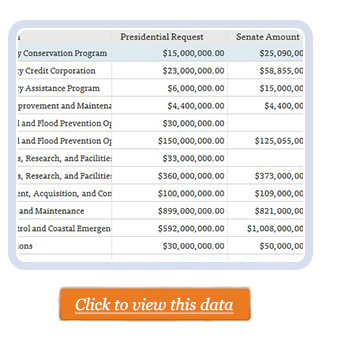As Washington debates the merits of a supplemental spending bill in response to superstorm Sandy, this database lists of all the spending in the various Sandy supplemental proposals and compares them with the administration’s original request. Also see this analysis of selected provisions and below for some high(low)lights of select sections. Here’s our weekly wastebasket that talks about emergency declaration gimmicks.

Clearly, Sandy was a very intense and damaging storm and there is an important role for the federal taxpayer aid those affected. But it is also critical that it be done in a limited and fiscally responsible way. Too often, lawmakers treat emergency spending as a honey pot for all their pet projects and initiatives. Out of one side of their mouth, lawmakers are saying that we need to deal with the across-the-board cuts that are sequestration and to reduce spending. Out of the other side of their mouth, they are calling a whole litany of regular spending items “emergency” to evade budget caps. We cannot afford business as usual. Business as usual got us into this $16.4 trillion debt hole, it’s sure not going to get us out of it.
Methodology
The data set contains the President’s original request, the Senate-passed proposal from the 112th Congress, the current House proposal (H.R. 152), and the Rep. Frelinghuysen (R-NJ) amendment to the House bill.
As far as the bill/amendment at hand, the upshot is that there are billions of dollars in spending that is not Sandy related. The amendment also strips out any local or state cost share for billions of dollars of Corps of Engineers projects – projects that were cost-shared in any previous disaster response. It also spends hundreds of millions of dollars on NOAA equipment that, while good to have to predict the next Sandy, are not emergency spending and should be budgeted
A few elements of the bill:
-
$25 million to improve weather forecasting and hurricane intensity forecasting (this should be in the regular budget)
-
$1 million for DEA to repair or replace 15 vehicles as well as some technology (BATF gets $230K to replace three vehicles and some furniture). For the record, the Department of Justice has over 40,000 vehicles – this should come out of agency budgets, not emergency.
-
$5.37 million for Army O&M to repair damaged facilities. This represents 0.01 percent of the Army’s FY12 regular O&M account (no war spending). I think a few sergeants could rummage through the couch cushions to come up with $5.37 million instead of emergency funding.
-
$3.461 billion for Corps construction projects, $2.9 billion of which is for the Sandy region, and sand pumping on beaches would be at full federal expense. Normal cost-share (even in disasters like Katrina) is 65 percent federal, 35 percent local or state.
-
$10 million for FBI salaries and expenses (this is more than double the $4 million requested by the President and in the previous Senate bill)
-
$2 million for Smithsonian roof repairs
-
$118 million for AMTRAK – $86 million more than the President requested and will be used on non-Sandy related Northeast Corridor upgrades
-
$2 billion for Federal Highway Administration to spend on roads across the country (obviously not Sandy related)
- $16 billion Community Development Fund that would go to not only Sandy states but to any major disaster declarations of 2011, 2012, and 2013 (OH had the latest major disaster declaration on January 3, 2013 – for Sandy!). That encompasses 47 states and Puerto Rico. Want to know who’s left out? Sorry Arizona, Michigan, and South Carolina, thanks for playing. Maybe you’ll have a disaster later this year.
Everyone knows we have to enact Sandy disaster assistance for the those impacted. But we have to be sure we do it in an appropriate and effective manner. The Frelinghuysen amended Sandy supplemental isn’t riddled with “pork” per se, in fact in many ways it’s better than what the Senate passed last year. But far too much of it is not emergency and should be done in the context of the regular budget process. We cannot afford to fund our prevention, protection, and resiliency in slip-shod occasional emergency spending bills. Instead, it should be ingrained in the regular budget process.
Terms of Use
Because all of the data we offer is public information, we ask that all users agree to these basic terms of use, that:
- information provided by TCS in whatever form is meant for research, educational, or journalistic purposes only;
- TCS Data shall not be used for commercial purposes, to solicit contributions, or sold to third-parties;
- and that appropriate credit will be given to TCS for all reports, articles, mashups, or other use of our data, including a link back to our website for all items published on the web.










